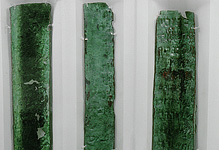
The Qumran Community
In 1947 two Beduin shepherds accidentally came accross a clay jar in a cave near Khirbet Qumran, that contained seven parchment scrolls. The Scrolls came into the hands of dealers who offered them to scholars. The first scholar to recognise their antiquity was E.L. Sukenik who succeeded in acquiring three of them for the Hebrew University. The other scrolls were smuggled to the United States where three of them were published in 1950 - 1951. Later they were offered for sale and Yigael Yadin, the son of Professor Sukenik, succeeded in buying them and bringing them back to Israel. The Israel Museum in Jerusalem constructed a special site for exhibiting the scrolls, the "Shrine of the Book".
The Community to which the Dead Sea Scrolls belonged occupied Qumran around 130 BCE to 70 CE. It was an extremist offshoot of the Jewish apocalyptic movement whose basic doctrine was the expectation of the end of days, soon to come. A "Teacher of Righteousness" was their spiritual and social leader. The sect followed its own interpretation of traditional Judaism, it stated that a calendar of 364 days had to be adopted.
Some scholars believe that both John the Baptist and Jesus spent time in Qumran.

#08040846
Strips of the copper scroll, found in cave 3 of Qumran

#08040847
Strips of a copper scroll,found in cave 3 of Qumran

#08040848
Strips of the copper scrolls found in cave 3 of Qumran.

#08040849
Fragments of Ecclesiastes - 4Q109 Kohelet From the Dead Sea Scrolls, found in...

#08040850
Copper inkpot found at Qumran.

#08050641
Ink pot found at Qumran

#08050642
A few lines (in Hebrew square writing) from one of the two scrolls of Isai...

#08050929
Ink pot from the scriptorium in Qumran. Herodian/Hasmonaean (?)...

#14030370
Shrine of the Book, Jerusalem, with an exhibit of some of the Dead Sea Scrolls.